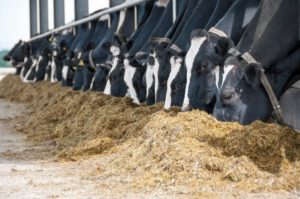At the time of writing this piece, maize crops still look drought-stressed with most of the central and south west regions being dry and brown resulting in silage stocks relying on a healthy 3rd cut once the rain arrives so growth can catch up. With winter forage stocks remaining questionable, we do know that feed prices remain inflated, but milk price is catching up and farms will be driving for performance to maximise milk sales.
Focus on the peak
This topic is a tale of two halves, early lactation cows are on an incline in both milk yield and dry matter intake. They typically reach a peak milk yield 50 – 70 days post-calving (days in milk) but can occur sooner. Every 1 litre increase in peak milk yield can equate to a 200 litre increase in lactation performance, because the drop in a lactation curve is controlled hormonally at a consistent 8-10% drop per month (heifers will typically drop more rapidly and peak at 70 – 80% of adult cow peaks), means that a persistent/flat lactation curve is rarely achieved. Therefore, achieving a higher peak milk yield can increase overall lactation yield, and feeding higher rates of supplements during this period will see greater yield responses and therefore return on costs.
This doesn’t happen without some risk, the second half of the equation is negative energy balance. Achieving a higher peak milk yield is positive for milk production, however, it does increase the risk of excessive weight loss which can reduce fertility performance. To mitigate the risk of this occurring it is important to get the basics right.
Focus on the basics
Intake is king, having high dry matter intake (DMI) gives options in the herd’s diet and shows cows have a healthy rumen. Where a herd average intake maybe 19 – 20kg DMI (3% BW) a peak yielding cows intake could be over 26kg DMI (4% BW+). Ensuring adequate feed and shed space is essential but regular feed pushing up will also encourage intakes, at least 6x per day. Push feed up 45 mins – 1 hour after feedout as well, this will ensure that submissive cows have adequate feed availability as they will often wait until the dominant cow have eaten and left the feed fence.
Monitor total dry matter intakes to ensure the diet formulated is relevant to the real diet fed,1kg of dry matter lower than expected can reduce yield by over 2 litres of milk. If intakes are lower than expected assess rumen health, a buffer may be required, yeast supplements can also help fibre digestibility and therefore intake. If cows appear full but intakes are not supporting peak yield, physical rumen space may be limited, therefore chopping the silage shorter (approx. 20mm) will help overall intakes.
Focus on balancing rations
Early lactation rationing should focus on achieving the following key components:
Dry matter intake – as previously discussed, rumen health and fibre levels are important factors when it comes to rumen health.
Fertility – laying down the platform for a healthy return to service will help overall farm performance. An optimal balance of protein (not too high, not too low!) and high glucogenic energy from starch and sugar sources will help a return to positive energy levels and therefore bulling activity.
Milk yield – peak milk yields are largely management and health-focused. Intakes are of course key but also focus closely on protein balance. High rumen available protein will quickly drive cows into milk post calving but could increase weight loss and ultimately reduce lactation yield. Feeding higher levels of by-pass protein such as Ultra Pro R and Ultra Soy can help cows achieve peak milk yield without the risk of weight loss.
For further information on winter rations and winter feeds, please speak to your local NWF Sales Specialist or click HERE to view our dairy range.
